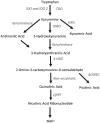Altered Tryptophan Catabolism in Placentas From Women With Pre-eclampsia
- PMID: 31007529
- PMCID: PMC6457019
- DOI: 10.1177/1178646919840321
Altered Tryptophan Catabolism in Placentas From Women With Pre-eclampsia
Abstract
Background: The kynurenine pathway enzymes, breaking down tryptophan, are abundant in placental tissue. These metabolites are involved in immunoregulatory mechanisms, although the role of this pathway in pre-eclampsia (PE) has only begun to be characterized. Here, we determined tryptophan and metabolite levels together with the expression of kynurenine pathway enzymes and inflammatory factors in placental tissue from women with and without PE.
Methods: Thirty-six placentas (18 PE and 18 controls) were analyzed for expression of kynurenine pathway enzymes indoleamine-2,3-dioxygenase (IDO1 and 2), tryptophan-2,3-dioxygenase (TDO), kynurenine-3-mono-oxygenase (KMO) and quinolinate phosphoribosyltransferase (QPRT) as well as interleukin (IL)-1β, IL-6, and serum amyloid A (SAA). Tryptophan and kynurenine content were measured using high-pressure liquid chromatography and quinolinic acid was measured using gas chromatography-mass spectrometry.
Conclusions: Tryptophan content was reduced in placentas from women with PE. There was an increased kynurenine/tryptophan ratio in placentas from women with PE but no significant change in downstream metabolites. We confirmed a reduction in IDO1 expression and found a compensatory increase in TDO expression in placentas from women with PE. SAA was reduced in PE placentas compared with controls. Our data show that tryptophan content and the inflammatory mediator SAA are both compromised in placentas from women with PE. Further studies on the role of tryptophan catabolism and mediators of inflammation in sustaining healthy immunobiological pathways in the placenta are warranted.
Keywords: indoleamine 2,3-dioxygenase; kynurenine pathway; pre-eclampsia; serum amyloid A; tryptophan; tryptophan 2,3-dioxygenase.
Conflict of interest statement
Declaration of conflicting interests:The author(s) declared no potential conflicts of interest with respect to the research, authorship, and/or publication of this article.
Figures



Similar articles
-
l-Tryptophan-Induced Vasodilation Is Enhanced in Preeclampsia: Studies on Its Uptake and Metabolism in the Human Placenta.Hypertension. 2020 Jul;76(1):184-194. doi: 10.1161/HYPERTENSIONAHA.120.14970. Epub 2020 Jun 1. Hypertension. 2020. PMID: 32475317
-
Tryptophan degradation enzymes expression in the placenta and the Kynurenine/Tryptophan ratio in maternal plasma after elective cesarean section.J Reprod Immunol. 2023 Mar;156:103823. doi: 10.1016/j.jri.2023.103823. Epub 2023 Feb 1. J Reprod Immunol. 2023. PMID: 36739732
-
Tryptophan degradation enzymes and Angiotensin (1-7) expression in human placenta.J Reprod Immunol. 2022 Sep;153:103692. doi: 10.1016/j.jri.2022.103692. Epub 2022 Aug 6. J Reprod Immunol. 2022. PMID: 35970080
-
Tryptophan: A Rheostat of Cancer Immune Escape Mediated by Immunosuppressive Enzymes IDO1 and TDO.Front Immunol. 2021 Feb 23;12:636081. doi: 10.3389/fimmu.2021.636081. eCollection 2021. Front Immunol. 2021. PMID: 33708223 Free PMC article. Review.
-
The Function of the Kynurenine Pathway in the Placenta: A Novel Pharmacotherapeutic Target?Int J Environ Res Public Health. 2021 Nov 3;18(21):11545. doi: 10.3390/ijerph182111545. Int J Environ Res Public Health. 2021. PMID: 34770059 Free PMC article. Review.
Cited by
-
Indoleamine 2,3-Dioxygenase-1 Expression is Changed During Bladder Cancer Cell Invasion.Int J Tryptophan Res. 2022 Jan 4;15:11786469211065612. doi: 10.1177/11786469211065612. eCollection 2022. Int J Tryptophan Res. 2022. PMID: 35002253 Free PMC article.
-
Tryptophan 2,3-Dioxygenase Expression Identified in Murine Decidual Stromal Cells Is Not Essential for Feto-Maternal Tolerance.Front Immunol. 2020 Dec 8;11:601759. doi: 10.3389/fimmu.2020.601759. eCollection 2020. Front Immunol. 2020. PMID: 33363543 Free PMC article.
-
Dysregulated placental expression of kynurenine pathway enzymes is associated with inflammation and depression in pregnancy.Brain Behav Immun. 2024 Jul;119:146-153. doi: 10.1016/j.bbi.2024.03.042. Epub 2024 Mar 29. Brain Behav Immun. 2024. PMID: 38555986 Free PMC article.
-
Neuroactive Kynurenines as Pharmacological Targets: New Experimental Tools and Exciting Therapeutic Opportunities.Pharmacol Rev. 2024 Oct 16;76(6):978-1008. doi: 10.1124/pharmrev.124.000239. Pharmacol Rev. 2024. PMID: 39304346 Free PMC article. Review.
-
Profiling of Tryptophan Metabolic Pathways in the Rat Fetoplacental Unit During Gestation.Int J Mol Sci. 2020 Oct 14;21(20):7578. doi: 10.3390/ijms21207578. Int J Mol Sci. 2020. PMID: 33066440 Free PMC article.
References
Grants and funding
LinkOut - more resources
Full Text Sources
Other Literature Sources
Research Materials

